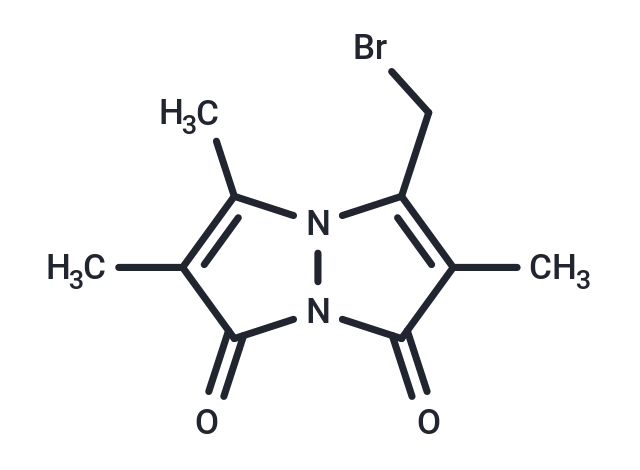Shopping Cart
Remove All Your shopping cart is currently empty
Your shopping cart is currently empty
Bromobimane (Monobromobimane) is a non-fluorescent substance, but reacts with thiols to produce a fluorescent product.Bromobimane is used as a probe, often in clinical medicine, to test for sulfide levels in blood.

| Pack Size | Price | USA Warehouse | Global Warehouse | Quantity |
|---|---|---|---|---|
| 10 mg | $36 | In Stock | In Stock | |
| 25 mg | $77 | In Stock | In Stock | |
| 50 mg | $133 | In Stock | In Stock | |
| 100 mg | $201 | In Stock | In Stock | |
| 1 mL x 10 mM (in DMSO) | $40 | In Stock | In Stock |
| Description | Bromobimane (Monobromobimane) is a non-fluorescent substance, but reacts with thiols to produce a fluorescent product.Bromobimane is used as a probe, often in clinical medicine, to test for sulfide levels in blood. |
| In vitro | Bromobimanes in solution (aqueous or organic solvents of medium polarity) react with small thiols, and with reactive protein thiol groups (e.g., hemoglobin). The reactions of bromobimanes with thiols are second-order and dependent on pH, the active nucleophile being the thiolate anion. The reaction of bromobimane with a thiolate converts the nonfluorescent agent into water-soluble fluorescent products [1]. The highly selective, rapid reactivity of bromobimanes toward thiols, the stability and fluorescence yield of the thiol derivatives, the ease of separation of the derivatives by reversed-phase HPLC, and the availability of both cell-penetrating and nonpenetrating forms, make the use bromobimanes an extremely powerful approach to the analysis of low molecular weight biothiols [2]. |
| Cell Research | Instructions I. Solution preparation: 1. Mother solution preparation: Dissolve Bromobimane in an appropriate solvent, such as anhydrous DMSO, DMF or methanol, to prepare a stock solution of the required concentration. 2. Working solution preparation: The recommended concentration of the stock solution is 100 mM for subsequent dilution. Dilute the stock solution to the working concentration, usually 10-50 μM. II. Operation steps Cell staining 1. Grow cells to an appropriate density; wash cells with PBS and remove the culture medium. 2. Add the diluted Bromobimane solution to the cells and incubate at 37°C in the dark for 15-30 minutes. 3. After incubation, wash the cells 3 times with PBS to remove unbound dye. 4. Fluorescence detection: Use a fluorescence microscope or flow cytometer for detection. The excitation wavelength of Bromobimane is about 390 nm and the emission wavelength is about 478 nm. Precautions: 1) Wear gloves during operation to avoid contact between skin or mucous membranes and reagents. 2) Avoid light exposure during incubation and storage to prevent fluorescence quenching. 3) After staining, fluorescence detection and analysis should be performed immediately. |
| Synonyms | Monobromobimane |
| Molecular Weight | 271.11 |
| Formula | C10H11BrN2O2 |
| Cas No. | 71418-44-5 |
| Smiles | Cc1c(C)c(=O)n2n1c(CBr)c(C)c2=O |
| Relative Density. | 1.66 g/cm3 (Predicted) |
| Storage | store at low temperature | Powder: -20°C for 3 years | In solvent: -80°C for 1 year | Shipping with blue ice/Shipping at ambient temperature. | |||||||||||||||||||||||||||||||||||
| Solubility Information | DMSO: 125 mg/mL (461.07 mM), Sonication is recommended. | |||||||||||||||||||||||||||||||||||
| In Vivo Formulation | 10% DMSO+40% PEG300+5% Tween-80+45% Saline: 2.5 mg/mL (9.22 mM), Sonication is recommeded. Please add the solvents sequentially, clarifying the solution as much as possible before adding the next one. Dissolve by heating and/or sonication if necessary. Working solution is recommended to be prepared and used immediately. The formulation provided above is for reference purposes only. In vivo formulations may vary and should be modified based on specific experimental conditions. | |||||||||||||||||||||||||||||||||||
Solution Preparation Table | ||||||||||||||||||||||||||||||||||||
DMSO
| ||||||||||||||||||||||||||||||||||||
| Size | Quantity | Unit Price | Amount | Operation |
|---|

Copyright © 2015-2025 TargetMol Chemicals Inc. All Rights Reserved.